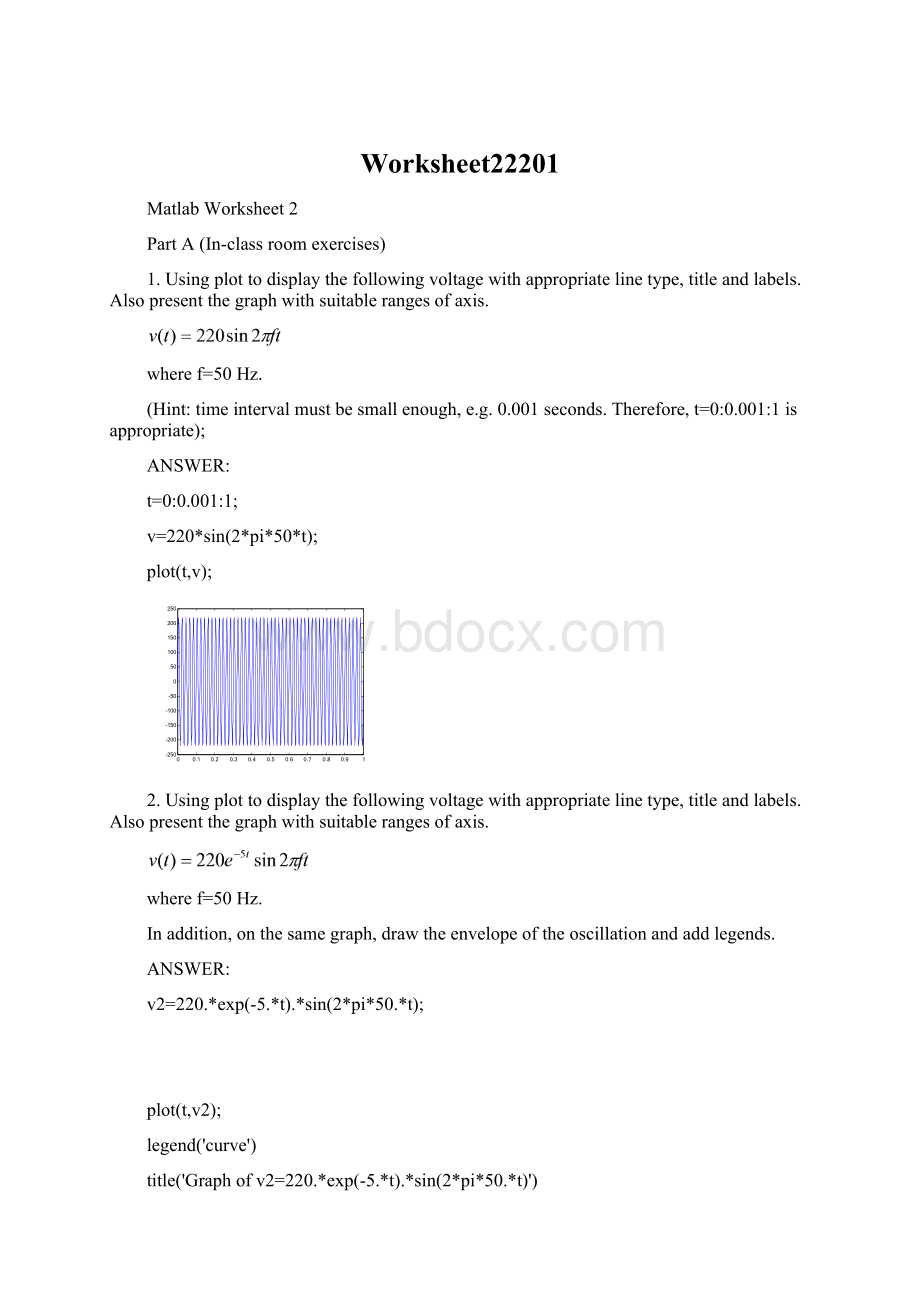Worksheet22201.docx
《Worksheet22201.docx》由会员分享,可在线阅读,更多相关《Worksheet22201.docx(34页珍藏版)》请在冰豆网上搜索。

Worksheet22201
MatlabWorksheet2
PartA(In-classroomexercises)
1.Usingplottodisplaythefollowingvoltagewithappropriatelinetype,titleandlabels.Alsopresentthegraphwithsuitablerangesofaxis.
wheref=50Hz.
(Hint:
timeintervalmustbesmallenough,e.g.0.001seconds.Therefore,t=0:
0.001:
1isappropriate);
ANSWER:
t=0:
0.001:
1;
v=220*sin(2*pi*50*t);
plot(t,v);
2.Usingplottodisplaythefollowingvoltagewithappropriatelinetype,titleandlabels.Alsopresentthegraphwithsuitablerangesofaxis.
wheref=50Hz.
Inaddition,onthesamegraph,drawtheenvelopeoftheoscillationandaddlegends.
ANSWER:
v2=220.*exp(-5.*t).*sin(2*pi*50.*t);
plot(t,v2);
legend('curve')
title('Graphofv2=220.*exp(-5.*t).*sin(2*pi*50.*t)')
xlabel('taxis')
ylabel('v-axis')
gridon
3.Usesubplot,drawa2by2arrayofplotsforthefollowingfunctions:
ANSWER:
Applyappropriatelinetype,title,labelsandaxisrangesforthegraphs.
v_1=cos(10*pi*t);
subplot(2,2,1);
plot(t,v_1);
xlabel('t'),ylabel('v1')
title('Graphofv_1=cos(10*pi*t)')
v_2=cos(10*pi*t).*exp(-5*t);
subplot(2,2,2);
plot(t,v_2);
xlabel('t'),ylabel('v2')
title('Graphofv_2=cos(10*pi*t).*exp(-5*t)')
v_3=cos(10*pi*t).*exp(-10*t);
subplot(2,2,3);
plot(t,v_3);
xlabel('t'),ylabel('v3')
title('Graphofv_3=cos(10*pi*t).*exp(-10*t)')
v_4=cos(10*pi*t).*exp(-20*t);
subplot(2,2,4);
plot(t,v_4);
xlabel('t'),ylabel('v4')
title('Graphofv_4=cos(10*pi*t).*exp(-20*t)')
4.Useplot3toplot2spiralcurveslikebelowwithappropriatelinewidthandcolour.
ANSWER:
t=0:
0.001:
10;
z=0.2*t;
x=sin(2*pi.*t).*z.*z;
y=cos(2*pi.*t).*z.*z;
plot3(x,y,z,'g','LineWidth',2);
holdon;
axis([-44-4402]);
holdoff;
z1=z.^0.5
x1=sin(2*pi.*t).*(z1)
y1=cos(2*pi.*t).*(z1)
plot3(x1,y1,z1,'r','LineWidth',2);
5.Displaythesurfaceusingmeshandcontourwithasuitableresolution:
ANSWER:
[x,y]=meshgrid(-2:
.1:
2,-2:
.2:
2);
f=exp(-0.005.*((x-50).^2+(y-50).^2));
figure
(1);
mesh(x,y,f);xlabel('x');ylabel('y');grid;
figure
(2);contour(x,y,f);
xlabel('x');ylabel('y');grid;
6.Load2ofyourphotosintoMatlabWorkSpaceusingimread.a)Changebrightnesslocallyorglobally.b)Overlapthemtoproduceanewphoto.c)writeanewphotointoafileusingimwrite.(Note:
lowerversionofMatlabsuchas6.5isnotallowedtodosomedirectimageoperations.)
ANSWER:
A=imread('11.jpg');
B=imread('22.jpg');
[MNP]=size(A);
imshow(A+100);
figure
(1);
C=A+B(1:
M,1:
N,1:
P);
imshow(C);
figure
(2);
imwrite(C,'33.jpg');
7.
theequationcoefficients:
A=[1-143
-545-6
07-89
-13-26];(M=N)
a)FindthedeterminantofA,
b)FindtheinverseofAandcheckformatrixsingularity,
c)IfB=[5;1;-2;3],findtheunknownxintheequation.
ANSWER:
a)det(A)
ans=
-765.0000
b)inv(A)
ans=
0.3333-0.00000.3333-0.6667
0.20000.11760.2706-0.3882
0.20000.05880.0353-0.0941
0.0222-0.0392-0.06800.2183
cond(A)
ans=
16.4186
c)x=inv(A)*b
ans=
-1.0000
-0.5882
0.7059
0.8627
8.Forlinearsimultaneousequations,
M>N,theequationcoefficients:
A=[1-143
-545-6
07-89
-13-26
1-253
147-3];
a)FindthedeterminantofA’*A,
b)FindtheinverseofA’*Aandcheckformatrixsingularity,
c)IfB=[5;1;-2;3;4;0],findthesolutionoftheequation.
ANSWER:
a)det(A'*A)
ans=
2.1051e+07
b)inv(A'*A)
ans=
0.08840.0321-0.0013-0.0219
0.03210.02310.0002-0.0099
-0.00130.00020.00850.0053
-0.0219-0.00990.00530.0144
cond(A'*A)
ans=
32.5278
c)x=inv(A'*A)*A'*B
x=
-0.8903
-0.4898
0.5755
0.7083
9.Dataof10recordsareshownbelow
y=[3.54.33.75.46.67.38.78.89.49.010.012.011.39.913.3],
Usepolyfitwithdifferentorders(from1to3)ofpolynomialstofindacurveofbestfit.Checkthetotaldistancebetweenthefittedcurvezandrecordsdefinedby
.
ANSWER:
x=linspace(0,1,15);
y=[3.54.33.75.46.67.38.78.89.49.010.012.011.39.913.3];
plot(x,y,'x');
holdon;
p=polyfit(x,y,1);
z=polyval(p,x);
s1=sqrt(sum((z-y).^2));%totaldistance
plot(x,z,'b','LineWidth',3);
holdon;
%一次拟合
p=polyfit(x,y,2);
z=polyval(p,x);
s2=sqrt(sum((z-y).^2));%totaldistance
plot(x,z,'r','LineWidth',3);
holdon;
%二次拟合
p=polyfit(x,y,3);
z=polyval(p,x);
s3=sqrt(sum((z-y).^2));%totaldistance
plot(x,z,'g','LineWidth',3);
%三次拟合
holdoff;
gridon;
s1=
3.2807
s2=
3.0399
s3=
3.0398
10.Createasetof20pointsfromacurvebyMatlabcode:
x=1:
20;y=2*exp(-0.3*(x-5).^2)+0.7*exp(-0.2*(x-12).^2);
Theninterpolatethecurveto60pointsusing‘linear’and‘spline’options,respectively.Seethequalityofdifferenttypesofinterpolation.
ANSWER:
xi=1:
0.25:
20;
yi=interp1(x,y,xi,'linear');
plot(x,y,'r*');holdon;
plot(xi,yi,'o');
plot(xi,yi,':
');
holdoff;
yi=interp1(x,y,xi,'spline');
figure
(2);
plot(x,y,'r*');holdon;
plot(xi,yi,'o');
plot(xi,yi,':
');
holdoff;
PartB
1.Usingtheplotandsubplotfunctionscreate4plotsona2by2arrayofsubplots,forthefunctionexp(-t)sin(5t)showingineachplotthefunctioninthecorrespondingintervalsofti.e.(-2,-1),(-1,0),(0,1)and(1,2).
Answer:
t=-2:
.01:
2;
x=exp(-t).*sin(5.*t);
subplot(2,2,1);
plot(t,x);axis([-2,-1-2020]);
subplot(2,2,2);
plot(t,x);axis([-1,0-2020]);
subplot(2,2,3);
plot(t,x);axis([0,1-2020]);
subplot(2,2,4);
plot(t,x);axis([1,2-2020]);
2.Athreephaseinductionmotorcharacteristicisgivenintermsofmechanicalshaftoutputtorque
(NMNewton-meter)asafunctionofrotationalspeedω(rad/sradianpersecond).Thisisapproximatedby3piece-wiselinearequationsasfollows:
Thismotorisdirectlycoupledtoaload
whichcanberepresentedas
Write2separateMatlabfunctionm-filesinwhich:
a)themotorcharacteristic,b)theloadcharacteristicaredefinedonlyasfunctionsofω.Namethemmotor.mandsysload.m,respectively.
Answer:
w=0:
0.01:
120*pi;
a)Tm=(w>=0&w<=90*pi).*w*(90*pi)+4+(w<=110*pi&w>90*pi).*(-10*w/(pi)+1200)+(w>110*pi&w<=120*pi).*(-10*w/(pi)+1200);
plot(w,Tm);
b)Tl=-50*(w/(120*pi)).^3+100*(w/(120*pi)).^2+4*w./(120*pi);
3.WriteaMatlabscripgt-mfilewhichcallsyourfunctionm-filesfromQuestion2.Andplotthemotorandloadcharactersticsonthesamefigure,givingsuitablelabellingandtitle.Namethisscriptm-filesystemplot.m
Answer:
w=0:
pi/20:
120*pi;
plot(w,Tm,'m','LineWidth',2); hold on;
plot(w,Tl,'r','LineWidth',2); hold off;
xlabel('speed w(rad/s_)');
ylabel('torque(NM Newton-meter)');
title('the motor and load characterstics');
legend('motor line','sysload line')
4.Writeasriptm-filewhichfindsallthemathematicallpossiblepoints(valuesofω)where
5.
fortherange0≤ω≤120π(rad/s)withthecharacteristicgiveninQuestion2.Thesystemcouldtheoreticallyoperateataspeedωwhere
Mathematically,thisinvolvesfindingtherootsoftheequation
Giveanametothism-fileposspoints.m.Callposspoints.minsystemplot.mandshowallofthepointsonasystemplotusingthe‘o’symbol.
Answer:
function[Tm]=tm(w)
Tm=(w>=0&w<=90*pi).*w*(90*pi)+4+(w<=110*pi&w>90*pi).*(-10*w/(pi)+1200)+(w>110*pi&w<=120*pi).*(-10*w/(pi)+1200);
end;
Function[T1]=t1(w)
Tl=-50*(w/(120*pi)).^3+100*(w/(120*pi)).^2+4*w./(120*pi);
end
(2)x
(1)=fzero(@tm,[60,90]); x
(2)=fzero(@tm,[300,320]); x(3)=fzero(@tm,[350,370]);
(3)w=0:
pi/20:
120*pi; Tm=tm(w);
plot(w,Tm,'m','LineWidth',2); hold on;
Tl=t1(w);
plot(w,Tl,'r','LineWidth',2); hold on;
xlabel('speed w(rad/s_)');
ylabel('torque(NM Newton-meter)');
title('the motor and load characterstics'); legend('motor line','sysload line') posspoints;
Tl=-50*(x/(120*pi)).^3+100*(x/(120*pi)).^2+4*x/(120*pi) plot(x,Tl,'ko','LineWidth',2); hold off; grid on;
PartC
IntroductiontoDSP
1.Basicdigitalsignals
Unitimpulsefunction
Exercise1-1:
DisplaytheunitimpulsefunctionwithMatlabcode.ThecodecanbeeithertypedunderMatlabpromptorwrittenintoascriptMatlabfile,thenrunthefile.
n=-10:
10;
fork=1:
21
x(k)=0;
end;
x(11)=1;
stem(n,x);
axis([-101002]);
Problem1-1:
Forthesignal
writetheMatlabcodeandcopytheresultfigureintothefollowingboxes.
n=-10:
10;
fork=1:
21
x(k)=0;
end;
x(9)=2;
stem(n,x);
axis([-101002]);
Unitstepfunction
Exercise1-2:
DisplaytheunitstepfunctionwithMatlabcode:
n=-10:
10;
fork=1:
10
x(k)=0;
end;
fork=11:
21
x(k)=1;
end;
stem(n,x);
axis([-101002]);
Problem1-2:
Forthesignal
writetheMatlabcode,anddisplaythecorrespondingsignalintothefollowingboxes.
n=-10:
10;
fork=1:
12
x(k)=0;
end;
fork=13:
21
x(k)=-1;
end;
stem(n,x);
axis([-1010-21]);
Sinewave
where-frequency(rad/second),T-samplinginterval(seconds)
Exercise1-3:
LetT=0.02,=6.28.Usingthefollowingcode,plotonthescreenintheregion0n100.
n=0:
100;
T=0.02;
omega=6.28;
fork=1:
101
x(k)=sin((k-1)*omega*T);
end;
stem(n,x);
Exercise1-3:
LetT=0.02,=6.28.Usingthefollowingcode,plotonthescreenintheregion0n100.
n=0:
100;
T=0.02;
omega=6.28;
fork=1:
101
x(k)=sin((k-1)*omega*T);
end;
stem(n,x);
Problem1-3:
Modifytheabovecodetodisplaythesignal:
whereT=0.02,=6.28.Executethecodeandplotthesignalonthescreen.Copythecode,thendisplaythesignalintothefollowingboxes.
n=0:
100;
T=0.02;
omega=6.28;
fork=1:
101
x(k)=2*sin((k-1)*omega*T+pi/2);
end;
stem(n,x);
Timeshift,impulseandstepresponses
Exercise1-4
Fortheunitimpulse,
andtheunitstep
writetwoMatlabfunctionsands